国际贸易实务教程(第二版)7-9章
- 格式:pptx
- 大小:1.35 MB
- 文档页数:46
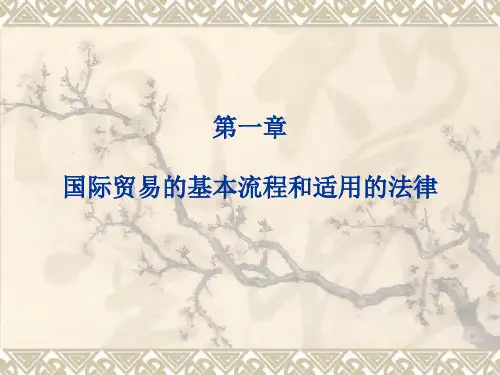
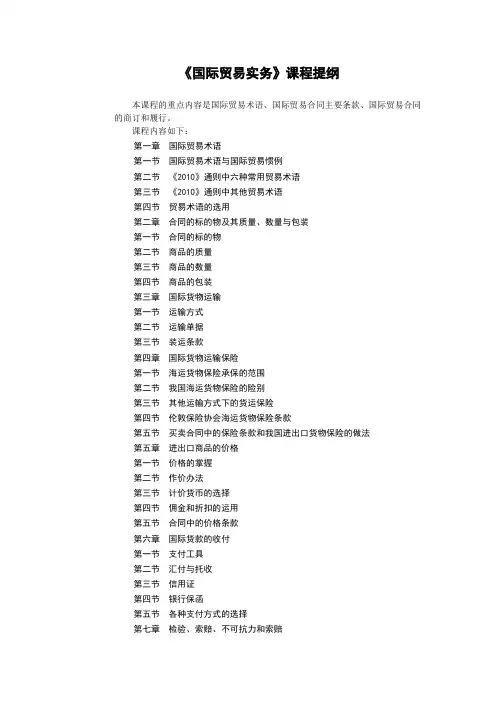
《国际贸易实务》课程提纲本课程的重点内容是国际贸易术语、国际贸易合同主要条款、国际贸易合同的商订和履行。
课程内容如下:第一章国际贸易术语第一节国际贸易术语与国际贸易惯例第二节《2010》通则中六种常用贸易术语第三节《2010》通则中其他贸易术语第四节贸易术语的选用第二章合同的标的物及其质量、数量与包装第一节合同的标的物第二节商品的质量第三节商品的数量第四节商品的包装第三章国际货物运输第一节运输方式第二节运输单据第三节装运条款第四章国际货物运输保险第一节海运货物保险承保的范围第二节我国海运货物保险的险别第三节其他运输方式下的货运保险第四节伦敦保险协会海运货物保险条款第五节买卖合同中的保险条款和我国进出口货物保险的做法第五章进出口商品的价格第一节价格的掌握第二节作价办法第三节计价货币的选择第四节佣金和折扣的运用第五节合同中的价格条款第六章国际货款的收付第一节支付工具第二节汇付与托收第三节信用证第四节银行保函第五节各种支付方式的选择第七章检验、索赔、不可抗力和索赔第一节商品检验第二节索赔第三节不可抗力第四节仲裁第八章国际货物进出口合同的商订与履行第一节国际货物进出口合同的磋商第二节国际货物进出口合同的订立第三节国际货物进出口合同的履行第九章贸易方式第一节经销与代理第二节寄售与展卖第三节招标投标与拍卖第四节商品期货交易与套期保值第五节对销贸易第六节加工贸易第十章国际电子商务EDI第一节电子商务的概念与分类第二节电子商务的特点第三节电子商务在外贸业务中的作用教材及参考文献1.《国际贸易实务模拟》,张建华主编,高等教育出版社,2002年7月第1版2.《现代国际贸易实务》,韩玉珍编著,首都经济贸易大学出版社2003年4月第2版3.《国际贸易结算案例及惯例》,石玉川等主编,对外经济贸易大学出版社,1998年3月第1版4.《国际贸易业务教程》,尤盛东,北京师范大学出版集团,2008年7月第1版5.《实用国际贸易》(英文),周振邦主编,青岛海洋大学出版社,1998年3月第1版6.《国际贸易实务》,黎孝先,对外经济贸易大学出版社,2011年7月第5版7.《进出口贸易实训及案例分析》,罗农,中国人民大学出版社,2006年3月第1版8.《国际贸易实务》,胡丹婷,机械工业出版社,2012年2月第2版9.《新编进出口贸易实务》,知识出版社,1992年版10.《出口贸易模拟教程》,祝卫,上海人民出版社,1999年版11.《进出口单证流转实务》,尹哲、修宗哲,中国轻工业出版社,1999年版12.《国际经贸理论、政策与实务》,华东师范大学出版社,1992年版复习题:一、填空题1.合同磋商的基本环节是和。
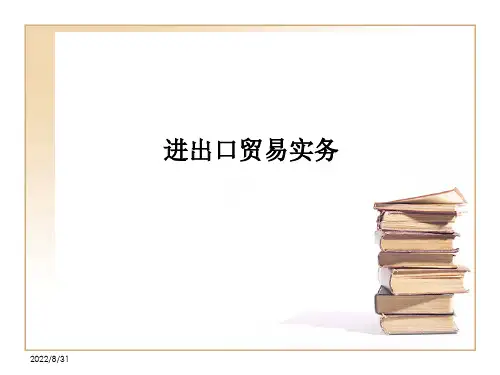
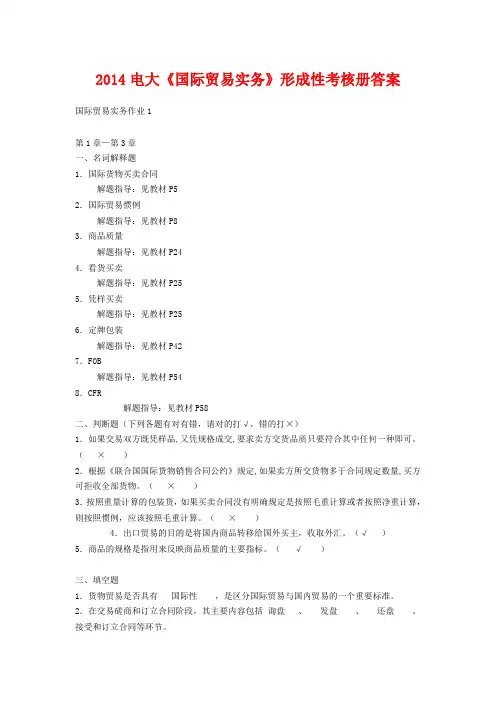
2014电大《国际贸易实务》形成性考核册答案国际贸易实务作业1第1章—第3章一、名词解释题1.国际货物买卖合同解题指导:见教材P52.国际贸易惯例解题指导:见教材P83.商品质量解题指导:见教材P244.看货买卖解题指导:见教材P255.凭样买卖解题指导:见教材P256.定牌包装解题指导:见教材P427.FOB解题指导:见教材P548.CFR解题指导:见教材P58二、判断题(下列各题有对有错,请对的打√,错的打×)1.如果交易双方既凭样品,又凭规格成交,要求卖方交货品质只要符合其中任何一种即可。
(×)2.根据《联合国国际货物销售合同公约》规定,如果卖方所交货物多于合同规定数量,买方可拒收全部货物。
(×)3.按照重量计算的包装货,如果买卖合同没有明确规定是按照毛重计算或者按照净重计算,则按照惯例,应该按照毛重计算。
(×)4.出口贸易的目的是将国内商品转移给国外买主,收取外汇。
(√)5.商品的规格是指用来反映商品质量的主要指标。
(√)三、填空题1.货物贸易是否具有国际性,是区分国际贸易与国内贸易的一个重要标准。
2.在交易磋商和订立合同阶段,其主要内容包括询盘、发盘、还盘、接受和订立合同等环节。
3.根据造成损失原因的不同,进口索赔的对象主要有三个方面:向卖方索赔、向船方(船公司)索赔、向保险公司索赔。
4.商品的名称、数量、质量和包装是国际货物买卖双方必须商定的交易条件,是双方进行交易的基础。
5.采用CPT术语的注意事项包括风险划分、装运通知、 CPT与CFR 。
6. FOB 、 CFR 、 CIF 术语仅适用于海运和内河运输,其承运人一般是船公司。
7. FCA 、 CPT 、 CIP 术语适用于各种运输方式,包括多式联运。
8.计价货币是指合同中规定用来计算价格的货币。
四、问答题1.国际货物买卖合同适用的法律一般包括哪几类?解题指导:见教材P62.国际贸易的程序是什么?解题指导:见教材P23.在国际贸易实务中,通常使用的计量重量的方法有哪些?解题指导:见教材P344.品质公差是什么?解题指导:见教材P315.在确定进出口商品价格时,外贸企业必须遵循哪些原则?解题指导:见教材P70五、综合分析题1.结合教材P54—P62,试分析FOB,CFR和CIF三种贸易术语的买卖双方的义务及异同点。
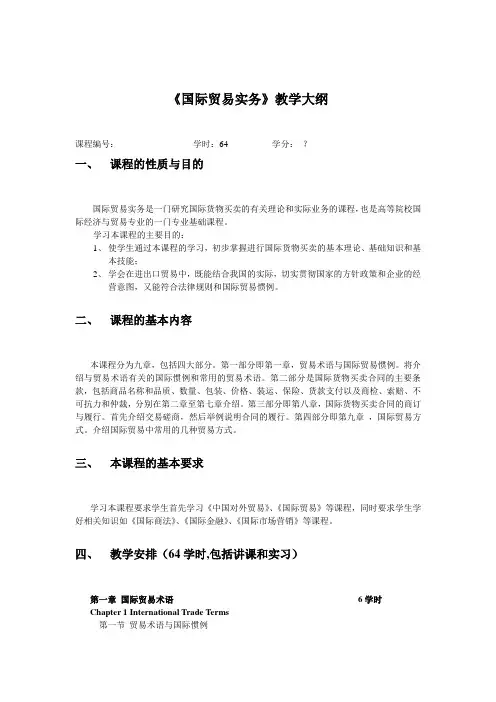
《国际贸易实务》教学大纲课程编号:学时:64 学分:?一、课程的性质与目的国际贸易实务是一门研究国际货物买卖的有关理论和实际业务的课程,也是高等院校国际经济与贸易专业的一门专业基础课程。
学习本课程的主要目的:1、使学生通过本课程的学习,初步掌握进行国际货物买卖的基本理论、基础知识和基本技能;2、学会在进出口贸易中,既能结合我国的实际,切实贯彻国家的方针政策和企业的经营意图,又能符合法律规则和国际贸易惯例。
二、课程的基本内容本课程分为九章,包括四大部分。
第一部分即第一章,贸易术语与国际贸易惯例。
将介绍与贸易术语有关的国际惯例和常用的贸易术语。
第二部分是国际货物买卖合同的主要条款,包括商品名称和品质、数量、包装、价格、装运、保险、货款支付以及商检、索赔、不可抗力和仲裁,分别在第二章至第七章介绍。
第三部分即第八章,国际货物买卖合同的商订与履行。
首先介绍交易磋商,然后举例说明合同的履行。
第四部分即第九章,国际贸易方式。
介绍国际贸易中常用的几种贸易方式。
三、本课程的基本要求学习本课程要求学生首先学习《中国对外贸易》、《国际贸易》等课程,同时要求学生学好相关知识如《国际商法》、《国际金融》、《国际市场营销》等课程。
四、教学安排(64学时,包括讲课和实习)第一章国际贸易术语6学时Chapter 1 International T rade T erms第一节贸易术语与国际惯例1.1 Trade Terms and International Rules第二节常用的三种贸易术语1.2 Three Most Popular Trade Terms第三节货交承运人的三种贸易术语1.3 Three Trade Terms on Delivering to Carrier第四节其他贸易术语1.4 Other Trade Terms第五节贸易术语的选用1.5 Selecting of Trade Terms第二章商品的名称及其质量、数量与包装4学时Chapter 2 Name and Quality of Commodity, Quantity and Packaging第一节商品的名称及其质量2.1 Name and Quality of Commodity第二节数量2.2 Quantity第三节包装2.3 Packaging第三章国际货物运输10学时Chapter 3 International Cargo T ransport第一节运输方式3.1 Transport Modes第二节装运条款3.2 Shipment Clause第三节运输单据3.3 Shipping Documents第四章国际货物运输保险6学时Chapter 4 Insurance of International Cargo T ransportation第一节概述4.1 An Overview of Insurance of International Cargo Transportation第二节海运货物保险承保的范围4.2 Insured Range in Ocean Transportation第三节我国海运货物保险的险别4.3 Ocean Marine Cargo Clause of CIC第四节伦敦保险协会海运货物保险条款4.4 Institute Cargo Clause (ICC)第五节我国陆运、空运货物与邮包运输保险4.5 Overland Transportation Cargo, Air Transportation Cargo and Parcel PostInsurance Clause第六节买卖合同中的保险条款4.6 Insurance Clauses of the contract第五章进出口商品的价格8学时Chapter 5 Price第一节定价时应考虑的问题5.1 Points considered in pricing第二节计价货币和支付货币的选择5.2 Choice of currency for account and payment第三节佣金与折扣5.3 Commission and Discounts第四节合同中的价格条款5.4 Clauses of Price第六章国际货款的收付14学时Chapter 6 International T rade Payment第一节支付工具6.1 Instruments of Payment第二节汇付与托收6.2 Remittance and Collection第三节信用证付款6.3 Letter of Credit第四节银行保函6.6 Banker’s Letter of Guarantee第五节合同中的支付条款6.5 Terms of Payment in Contract第七章检验、索赔、不可抗力与仲裁4学时Chapter 7 Inspection, Claim, Force Majeure and Arbitration第一节检验7.1 Inspection第二节索赔7.2 Claim第三节不可抗力7.3 Force Majeure第四节仲裁7.4 Arbitration第八章合同的商订与履行8学时Chapter 8 T rade Negotiation and Contract Performing第一节合同的商订8.1 Trade Negotiation第二节合同的履行8.2 Contract Performing第九章国际贸易方式4学时Chapter 9 International T rade Modes第一节经销与代理9.1 Distributorship and Agency第二节寄售与展卖9.2 Consignment, Fairs and Sales第三节招标投标与拍卖9.3 Invitation to tenders, Submission of tenders and Auction第四节期货交易与套期保值9.4 Futures Trading and Hedging第五节对销贸易9.5 Counter Trade第六节加工贸易9.6 Improvement Trade第七节电子商务9.7 Commercial Business五、教材和参考资料教材:《国际贸易实务》对外经济贸易大学出版社,黎孝先主编《International Trade Theory and Practice》对外经济贸易大学出版社,张素芳编著参考书:1、吴百福主编.《进出口贸易实务教程》.上海人民出版社2003年版2、《对外贸易实务》中国对外经济贸易教育协会主办(月刊)3、《中国海关》中国海关出版社主办(月刊)4、商务部、海关等相关网站5、杨玲等.《国际贸易与国际金融》.武汉大学出版社《国际贸易实务》课程简介课程编号:课程名称:国际贸易实务英文名称:International Trade Practice学时:50 学分:2.5课程简介:国际贸易实务是一门研究国际货物买卖的有关理论和实际业务的课程,也是高等院校国际经济与贸易专业的一门专业基础课程。
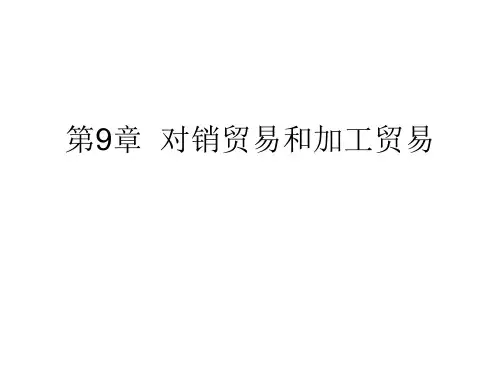
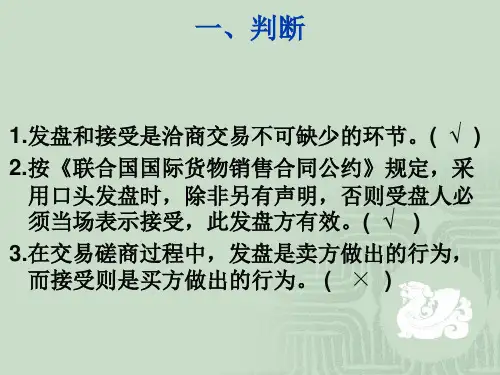
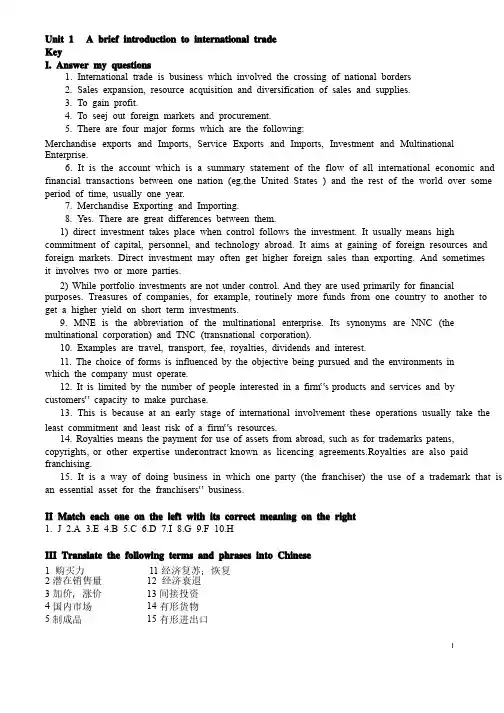
1 Unit 1 A brief introduction to international tradeKeyI. Answer my questions1. International trade is business which involved the crossing of national borders 2. Sales expansion, resource acquisition and diversification of sales and supplies. 3. To gain profit. 4. To seej out foreign markets and procurement. 5. There are four major forms which are the following: Merchandise exports and Imports, Service Exports and Imports, Investment and and Multinational Multinational Enterprise. 6. It is the account which is a summary statement of the flow of all international economic and financial transactions between one nation (eg.the United States ) and the rest of the world over some period of time, usually one year. 7. Merchandise Exporting and Importing. 8. Yes. There are great differences between them. 1) 1) direct direct direct investment investment investment takes takes takes place place place when when when control control control follows follows follows the the the investment. investment. investment. It It It usually usually usually means means means high high commitment of capital, personnel, and technology abroad. It aims at gaining of foreign resources and foreign markets. Direct investment may often get higher foreign sales than exporting. And sometimes it involves two or more parties. 2) 2) While While While portfolio portfolio portfolio investments investments investments are are are not not not under under under control. control. control. And And And they they they are are are used used used primarily primarily primarily for for for financial financial purposes. Treasures of companies, for example, routinely more funds from one country to another to get a higher yield on short term investments. 9. MNE is the abbreviation of the multinational enterprise. Its synonyms are NNC (the multinational corporation) and TNC (transnational corporation). 10. Examples are travel, transport, fee, royalties, dividends and interest. 11. 11. The The The choice choice choice of of of forms forms forms is is is influenced influenced influenced by by by the the the objective objective objective being being being pursued pursued pursued and and and the the the environments environments environments in in which the company must operate. 12. 12. It It It is is is limited limited limited by by by the the the number number number of of of people people people intere intere interested sted sted in in in a a a firm‟s firm‟s products products and and and services services services and and and by by customers‟ capacity to make purchase.13. This is because at an early stage of international involvement these operations usually take the least commitment and least risk of a firm‟s resources.14. 14. Royalties Royalties Royalties means means means the the the payment payment payment for for for use use use of of of assets assets assets from from from abroad, abroad, abroad, such such such as as as for for for trademarks trademarks trademarks patens, patens, copyrights, copyrights, or other expertise under or other expertise under contract contract known as licencing agreements.Royalties are also paid known as licencing agreements.Royalties are also paid franchising. 15. It is a way of doing business in which one party (the franchiser) the use of a trademark that is an essential asset for the franchisers‟ business.II Match each one on the left with its correct meaning on the right1. J 2.A 3.E 4.B 5.C 6.D 7.I 8.G 9.F 10.H III Translate the following terms and phrases into Chinese1 购买力11经济复苏;恢复2潜在销售量12 经济衰退3加价,涨价13间接投资4国内市场14有形货物5制成品15有形进出口6边际利润边际利润 16收入及支出;岁入及岁出收入及支出;岁入及岁出7市场占有率市场占有率 17超额能力超额能力 8贸易歧视贸易歧视 18贸易中间人(商);经纪人;经纪人9时机选择时机选择 19全部包建的工程承包方式全部包建的工程承包方式10经销周期经销周期 20许可证协定许可证协定IV Case Study 1 [Answer]:Batteries Batteries called called called "white "white "white elephant" elephant" elephant" exported exported exported from from from China China China were were were very very very popular popular popular in in in Southeast Southeast Southeast Asia, Asia, because "white elephant" was a lucky thing in Southeast Asia, but no one was interested in it in the market of Europe and the United States. The boss of the company was very strange that the quality of the the battery battery battery or or or the the the price price price of of of reasons, reasons, reasons, so so so he he he asked asked asked his his his staff staff staff to to to investigate. investigate. investigate. Finally Finally Finally he he he found found found that that that is is is the the brand "white elephant" to be blame. The brand's name translated into English was "white elephant" which which meant meant meant something something something were were were no no no use use use but but but cumbersome cumbersome cumbersome in in in Western Western Western countries. countries. countries. It It It was was was really really really a a a bad bad translation from culture information perspective. The meaning derived from a legend. According to the legend, legend, there there there was was was a a a king king king who who who hated hated hated a a a minister, minister, minister, so so so he he he gave gave gave a a a white white white elephant elephant elephant to to to the the the minister minister minister for for punishment. The minister has to take care of the white elephant, he couldn't give it to others or kill it because it's the king gave it to him. However, the appetite of the white elephant was so great, and the minister became poorer. So it showed people in western countries would not buy the battery for the consumers have no willing to buy something useless but cumbersome. V . OpenVI.Translate the following into English 1. Trade is often the …engine‟ of growth. However oversimplified this metaphor may be, it does serve to underline the importance of foreign trade in the process of growth. A healthy expansion of exports may not always be sufficient condition for rapid and sustained growth, but a strong positive association between the two is clearly undeniable. Trade expansion contributes to economic growth in many many ways. ways. ways. Among Among Among them them them are are are the the the benefits benefits benefits of of of specialization; specialization; specialization; the the the favorable favorable favorable effects effects effects of of of international international competition on domestic economic efficiency; the increased capacity to pay for the imports required in development and more generally the stimulus to investment. 2. International trade is the exchange of goods and services produced in one country for goods and services produced in another country. In addition to visible trade, which involves the import and export of goods and merchandise, there is also invisible trade, which involves the exchange of services between between nations. nations. nations. Nations Nations Nations such such such as as as Greece Greece Greece and and and Norway Norway Norway have have have large large large maritime maritime maritime fleets fleets fleets and and and provide provide transportation transportation service. service. service. This This This is is is a kind a kind of invisible trade. I nvisible trade Invisible trade can be as important to to some some nations as the export of raw materials or commodities is to others. In both cases, the nations earn the money to buy necessities. 3. There exist different ways of conducting international business. Exclusive sale means the seller gives the overseas client the exclusive right of selling a particular product in a designated area within a specified period of time. In this kind of business transaction, the product is bought by the exclusive seller and therefore he should sell the product by himself, assuming sole responsibilities for his profit and loss. Exclusive sale is different from agency where only commission is involved. And difference exists between general contract and exclusive sales because the exclusive seller enjoys exclusive right in a particular area. 4. There is no country in the world that can produce all the products it needs. Thus countries join in international division of labor for effective production and reproduction. Sometimes a country can buy buy goods goods goods and and and services services services from from from abroad abroad abroad on on on a a a barter barter barter basis. basis. basis. Barter Barter Barter means means means doing doing doing business business business by by by exchanging exchanging goods of one sort for goods of another sort without using money. Barter trade itself is not enough to meat a cou n try‟s import needs. But as a form of international trade, it is still attractive in developing ntry‟s import needs. But as a form of international trade, it is still attractive in developing countries where foreign exchange is in short supply and inflow of foreign funds is far from sufficient to meet their obligations in external trade. Unit 2 General Procedures of Export and Import TransactionI. Answer the following questions(Omited) II. Filling the blanks with the suitable words in the text:1.meeting/satisfying; 2.agent, foreign/overseas; mission; 4.own; 5.setting; 6.patent; 7.profits; 8.outlets; 9.joint, venture; 10.subsidiary III. J udge the following statement, mark True (T) or False(F)1F 2. T 3. F 4. F 5.F 6.F 7.T 8.F 9.F 10. T IV . Explain the meaning of the words or phrases below as requested 1. Offer: An offer is a proposal made by sellers to buyers in order to enter into the contract. 2. 2. Withdrawal: Withdrawal: It It means means means an an an offer offer offer by by by the the the offerer offerer offerer has has has been been been withdrawn withdrawn withdrawn before before before it it it is is is reached reached reached to to to the the offeree in order to prevent its entry into force. 3. Enquiry: An enquiry is a request for business information, such as price lists, catalogue, samples, and details of the goods or trade terms. It can be made either by the importer or the exporter. 4. Acceptance: Acceptance is a statement made by other conduct of the offerees indicating unconditional consent to an offer. 5. Shipping agent: Shipping agent(船代)is a ship owner's representative whose job is to find the ships to carry.V . Compose a letter of enquiry with the following particulars:KeysMessrs. Arthur Grey & Son, 19 Cheapside, London, E.C.2 Dear Sirs, We have obtained y our name and address from China Council for Promotion of International Trade your name and address from China Council for Promotion of International Trade and learned that you are one of the leading exporters of Ice Box in your district. We are now interested in 100 sets of the said article and should be pleased if you would let us know whether you can supply us with the quantity and quality we desire. Please quote us your best price on CIF Guangzhou basis. When offering, please state clearly terms of payment, time of delivery, packing conditions together with illustrated catalogue for our consideration. We are looking forward to your early reply. Yours faithfully, VI. Please make your offer according to the following particulars: KeyDear Sirs, Thank you for your letter of 5th May. We are glad to learn of the inquiries you have had from your your customers customers customers for for for our our our raincoats. raincoats. raincoats. Our Our Our "D.D." "D.D." "D.D." range range range is is is particularly particularly particularly suitable suitable suitable for for for warm warm warm climates, climates, climates, and and during the past years we have supplied this range to dealers in several tropical countries, from many of whom we have already had repeated orders. This range is popular not only because it is light in weight, but also because the material used has been specially treated to prevent excessive condensation on the inside surface. For the quantities you mention we are pleased to quote as follows: "D.D." Raincoats 100 men's medium @ US$14.50 US$ 1,450 100 men's small 14.0 1,400 100 women's medium 13.2 1,320 100 women's small 12.7 1,270 US$ 5,440 Payment: by irrevocable L/C at sight Shipment: Shipment will be effected within three or four weeks after receiving the L/C. This This offer offer offer is is is subject subject subject to to to our our our final final final confirmation. confirmation. confirmation. We We We feel feel feel you you you may may may be be be interested interested interested in in in our our our other other products and enclose some pamphlets for your reference. We are awaiting your early orders. Yours sincerely, VII. Write a counter-offer according to the following particulars:Keys: Dear Sirs, We thank you for your quotation May 10 for 1,000 sets of Hair IceBox. We find your price as well as delivery date satisfactory, however, we would give our suggestions of an alternation of your payment terms. Our past purchase of other household electrical appliances from you has been paid as a rule by confirmed, irrevocable letter of credit at sight. On the basis, it has indeed cost us a great deal. From the moment to open credit till the time our buyers pay us, the tie-up of our funds lasts about four months. Under the present circumstances, this question is particular taxing owing to the tight money condition and unprecedentedly high bank interests. In view of our long business relations and our amicable cooperation prospects, we suggest that you accept either “cash against documents on arrival of goods ” or “drawing on us at 60 day ‟s sight ”. Your first priority to the consideration of the above request and an early favorable reply will be highly appreciated. Yours sincerely,VIII. Translate the followings into English1). Economic activity began with the cavemen, who was economically self-sufficient. He did his own hunting, found his own shelter, and provided for his own needs. As primitive populations grew and developed, the principle of division of labor evolved. One person was more able to perform some activity than another, and therefore each person concentrated on what he did best. While one hunted, another fished. The hunter then traded his surplus to the fisherman, and each benefited from the variety of diet. In today‟s complex economic world, neither individuals nor nations are self -sufficient nations are self-sufficient. self-sufficient. Nations Nations Nations have have have utilized utilized utilized different different different economic economic economic resources; resources; resources; people people people have have have developed developed developed different different skills. This is the foundation of international trade and economic activities. Foreign trade, the exchange of goods between nations, takes place for many reasons. The first, as mentioned mentioned above, above, above, is is is that that that no no no nation nation nation has has has all all all of of of the the the commodities commodities commodities than than than it it it needs. needs. needs. Raw Raw Raw materials materials materials are are scattered around the world. Large deposits of copper are mined in Peru and Zaire, diamonds are mined in South Africa, and petroleum is recovered in Middle East. Countries that do not have these resources within their own boundaries must buy from countries that export them. Foreign trade also occurs because a country often does not have enough of a particular item to meet its needs. Although the United States is a major producer of sugar, it consumes more than it can produce internally and thus must import sugar. Third, one nation can sell some items at a lower cost than other countries. Japan has been able to export large quantities of radios and television sets because it can produce them more efficiently than other other countries. countries. countries. It It It is is is cheaper cheaper cheaper for for for the the the United United United States States States to to to buy buy buy these these these from from from Japan Japan Japan than than than to to to produce produce produce them them domestically. Finally, foreign trade takes place because of innovation or style. Even though the United States produces produces more more more automobiles automobiles automobiles than than than any any any other other other country, country, country, it it it still still still imports imports imports large large large quantities quantities quantities of of of autos autos autos from from Germany, Japan and Sweden, primarily because there is a market for them in the United States.2). The different kinds of trade nations engaged in are varied and complex, a mixture of visible and invisible trade. Most nations are more dependent on exports than on any other activity. The earnings from exports pay for the imports that they need and want. A nation‟s balance of payment is a record of these complex transactions. By reflecting all of these transactions in monetary terms , a nation is able to to combine combine combine the the the income income income it it it receives, receives, receives, for for for example, example, example, from from from exports, exports, exports, tourists tourists tourists expenditures, expenditures, expenditures, and and and immigrant immigrant remittances. This combined incomes is t hen spent then spent on such items as manufactured goods from o ther other countries, travel for its citizens to other countries, and the hiring of construction engineers. IX. Case Study [Answer]: A 公司与B 公司的第一封信函可视为发盘,在该发盘中A 公司对包装做出了要求。
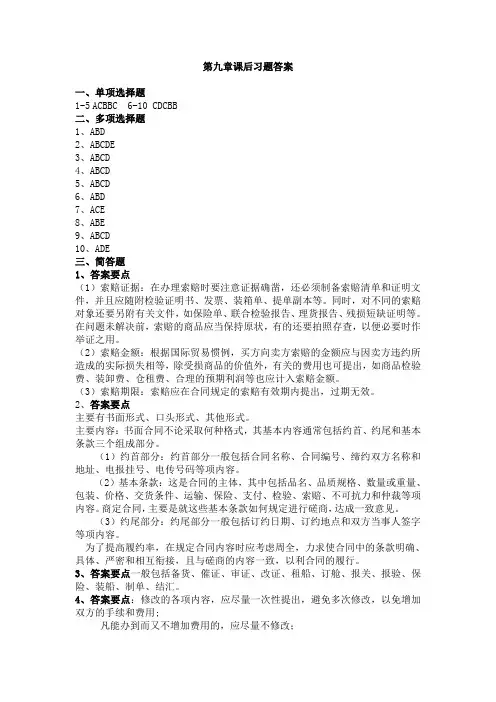
第九章课后习题答案一、单项选择题1-5ACBBC 6-10 CDCBB二、多项选择题1、ABD2、ABCDE3、ABCD4、ABCD5、ABCD6、ABD7、ACE8、ABE9、ABCD10、ADE三、简答题1、答案要点(1)索赔证据:在办理索赔时要注意证据确凿,还必须制备索赔清单和证明文件,并且应随附检验证明书、发票、装箱单、提单副本等。
同时,对不同的索赔对象还要另附有关文件,如保险单、联合检验报告、理货报告、残损短缺证明等。
在问题未解决前,索赔的商品应当保持原状,有的还要拍照存查,以便必要时作举证之用。
(2)索赔金额:根据国际贸易惯例,买方向卖方索赔的金额应与因卖方违约所造成的实际损失相等,除受损商品的价值外,有关的费用也可提出,如商品检验费、装卸费、仓租费、合理的预期利润等也应计入索赔金额。
(3)索赔期限:索赔应在合同规定的索赔有效期内提出,过期无效。
2、答案要点主要有书面形式、口头形式、其他形式。
主要内容:书面合同不论采取何种格式,其基本内容通常包括约首、约尾和基本条款三个组成部分。
(1)约首部分:约首部分一般包括合同名称、合同编号、缔约双方名称和地址、电报挂号、电传号码等项内容。
(2)基本条款:这是合同的主体,其中包括品名、品质规格、数量或重量、包装、价格、交货条件、运输、保险、支付、检验、索赔、不可抗力和仲裁等项内容。
商定合同,主要是就这些基本条款如何规定进行磋商,达成一致意见。
(3)约尾部分:约尾部分一般包括订约日期、订约地点和双方当事人签字等项内容。
为了提高履约率,在规定合同内容时应考虑周全,力求使合同中的条款明确、具体、严密和相互衔接,且与磋商的内容一致,以利合同的履行。
3、答案要点一般包括备货、催证、审证、改证、租船、订舱、报关、报验、保险、装船、制单、结汇。
4、答案要点:修改的各项内容,应尽量一次性提出,避免多次修改,以免增加双方的手续和费用;凡能办到而又不增加费用的,应尽量不修改;修改应及时提出,以避免因拖延时间过长,造成银行认为我方已接受的误解;对信用证的修改书也应该认真审核,防止国外客户趁机修改、添加、删除一些重要的内容;修改书应由原通知行传递;对通知转来的修改通知书内容,如经审核不能接受时,就及时表示拒绝;一份修改通知书中包含许多内容,只能全部接受或全部拒绝,不能只接受一部分。
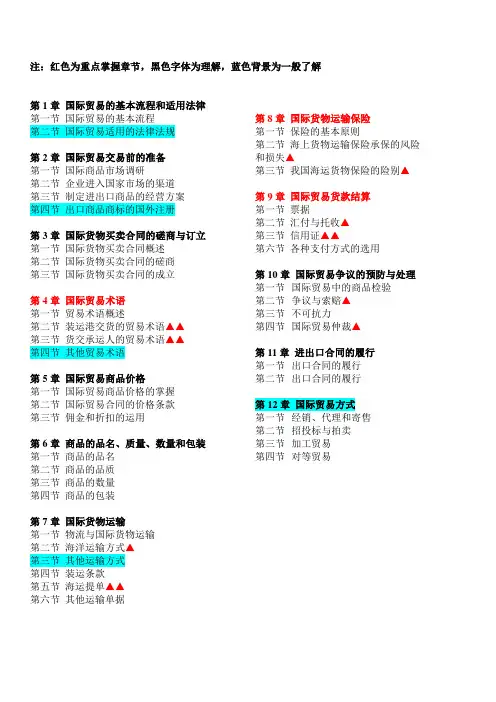
注:红色为重点掌握章节,黑色字体为理解,蓝色背景为一般了解第1章国际贸易的基本流程和适用法律第一节国际贸易的基本流程第二节国际贸易适用的法律法规第2章国际贸易交易前的准备第一节国际商品市场调研第二节企业进入国家市场的渠道第三节制定进出口商品的经营方案第四节出口商品商标的国外注册第3章国际货物买卖合同的磋商与订立第一节国际货物买卖合同概述第二节国际货物买卖合同的磋商第三节国际货物买卖合同的成立第4章国际贸易术语第一节贸易术语概述第二节装运港交货的贸易术语▲▲第三节货交承运人的贸易术语▲▲第四节其他贸易术语第5章国际贸易商品价格第一节国际贸易商品价格的掌握第二节国际贸易合同的价格条款第三节佣金和折扣的运用第6章商品的品名、质量、数量和包装第一节商品的品名第二节商品的品质第三节商品的数量第四节商品的包装第7章国际货物运输第一节物流与国际货物运输第二节海洋运输方式▲第三节其他运输方式第四节装运条款第五节海运提单▲▲第六节其他运输单据第8章国际货物运输保险第一节保险的基本原则第二节海上货物运输保险承保的风险和损失▲第三节我国海运货物保险的险别▲第9章国际贸易货款结算第一节票据第二节汇付与托收▲第三节信用证▲▲第六节各种支付方式的选用第10章国际贸易争议的预防与处理第一节国际贸易中的商品检验第二节争议与索赔▲第三节不可抗力第四节国际贸易仲裁▲第11章进出口合同的履行第一节出口合同的履行第二节出口合同的履行第12章国际贸易方式第一节经销、代理和寄售第二节招投标与拍卖第三节加工贸易第四节对等贸易案例分析答案第四章国际贸易术语案例讨论1.我国北方A化工进出口公司与美国加利福尼亚B化学制品公司按照FOB大连条件签订了一笔化工原料的买卖合同。
A公司在规定的装运期届满前三天将货物装上B公司指派的某新加坡轮船公司的海轮上,且装船前检验时,货物的品质良好,符合合同的规定。
货到目的港旧金山,B公司提货后经目的港商检机构检验发现部分货物结块,品质发生变化。
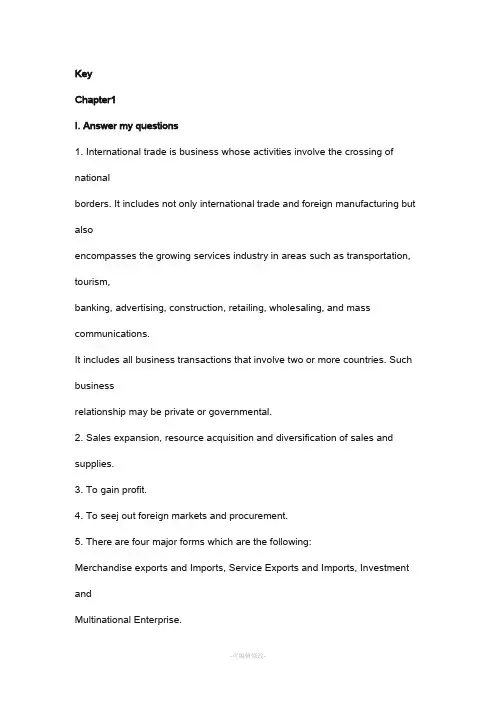
KeyChapter1I. Answer my questions1. International trade is business whose activities involve the crossing of nationalborders. It includes not only international trade and foreign manufacturing but alsoencompasses the growing services industry in areas such as transportation, tourism,banking, advertising, construction, retailing, wholesaling, and mass communications.It includes all business transactions that involve two or more countries. Such businessrelationship may be private or governmental.2. Sales expansion, resource acquisition and diversification of sales and supplies.3. To gain profit.4. To seej out foreign markets and procurement.5. There are four major forms which are the following:Merchandise exports and Imports, Service Exports and Imports, Investment andMultinational Enterprise.6. It is the account which is a summary statement of the flow of all international economic and financial transactions between one nation (eg.the United States ) andthe rest of the world over some period of time, usually one year.7. Merchandise Exporting and Importing.8. Yes. There are great differences between them.1) direct investment takes place when control follows the investment. It usually means high commitment of capital, personnel, and technology abroad. It aims atgaining of foreign resources and foreign markets. Direct investment may often gethigher foreign sales than exporting. And sometimes it involves two or more parties.2) While portfolio investments are not under control. And they are used primarilyfor financial purposes. Treasures of companies, for example, routinely more fundsfrom one country to another to get a higher yield on short term investments. 9. MNE is the abbreviation of the multinational enterprise. Its synonyms are NNC(the multinational corporation) and TNC (transnational corporation).10. Examples are travel, transport, fee, royalties, dividends and interest.11. The choice of forms is influenced by the objective being pursued and the environments in which the company must operate.12. It is limited by the number of people interested in a firm’s products and services and by customers’ capacity to make purchase.13. This is because at an early stage of international involvement these operationsusually take the least commitment and least risk of a firm’s resources.14. Royalties means the payment for use of assets from abroad, such as for trademarks patens, copyrights, or other expertise under contract known as licencingagreements.Royalties are also paid franchising.15. It is a way of doing business in which one party (the franchiser) the use of a trademark that is an essential asset for the franchisers’ business.II Match each one on the left with its correct meaning on the right1. J2.A3.E4.B5.C6.D7.I8.G9.F 10.HIII Translate the following terms and phrases into Chinese1 购买力11 经济复苏;恢复2 潜在销售量12 经济衰退3 加价,涨价13 间接投资4 国内市场14 有形货物5 制成品15 有形进出口6 边际利润16 收入及支出;岁入及岁出7 市场占有率17 超额能力8 贸易歧视18 贸易中间人(商);经纪人9 时机选择19 全部包建的工程承包方式10 经销周期20 许可证协定IV Translate the following into English1. Trade is often the ‘engine’ of growth. However oversimplified this metaphor may be, it does serve to underline the importance of foreign trade in the process ofgrowth. A healthy expansion of exports may not always be sufficient condition forrapid and sustained growth, but a strong positive association between the two isclearly undeniable. Trade expansion contributes to economic growth in many ways.Among them are the benefits of specialization; the favorable effects of internationalcompetition on domestic economic efficiency; the increased capacity to pay for theimports required in development and more generally the stimulus to investment.2. International trade is the exchange of goods and services produced in one country for goods and services produced in another country. In addition totrade, which involves the import and export of goods and merchandise, there is alsoinvisible trade, which involves the exchange of services between nations. Nationssuch as Greece and Norway have large maritime fleets and provide transportationservice. This is a kind of invisible trade. Invisible trade can be as important to somenations as the export of raw materials or commodities is to others. In both cases, thenations earn the money to buy necessities.3. There exist different ways of conducting international business. Exclusive salemeans the seller gives the overseas client the exclusive right of selling a particularproduct in a designated area within a specified period of time. In this kind of businesstransaction, the product is bought by the exclusive seller and therefore he should sellthe product by himself, assuming sole responsibilities for his profit and loss. Exclusive sale is different from agency where only commission is involved.difference exists between general contract and exclusive sales because the exclusiveseller enjoys exclusive right in a particular area.4. There is no country in the world that can produce all the products it needs. Thus countries join in international division of labor for effective production and reproduction. Sometimes a country can buy goods and services from abroad on abarter basis. Barter means doing business by exchanging goods of one sort for goodsof another sort without using money. Barter trade itself is not enough to meat a country’s import needs. But as a form of international trade, it is still attractive indeveloping countries where foreign exchange is in short supply and inflow of foreignfunds is far from sufficient to meet their obligations in external trade.Chapter2I. Answer the following questions(Omited)II. Filling the blanks with the suitable words in the text:1.meeting/satisfying;2.agent, foreign/overseas;mission;4.own;5.setting;6.patent;7.profits;8.outlets;9.joint, venture; 10.subsidiaryIII.Translate the followings into English1). Economic activity began with the cavemen, who was economicallyself-sufficient. He did his own hunting, found his own shelter, and provided for hisown needs. As primitive populations grew and developed, the principle of division oflabor evolved. One person was more able to perform some activity than another, andtherefore each person concentrated on what he did best. While one hunted, anotherfished. The hunter then traded his surplus to the fisherman, and each benefited fromthe variety of diet.In today’s complex economic world, neither individuals nor nations areself-sufficient nations are self-sufficient. Nations have utilized different economicresources; people have developed different skills. This is the foundation of international trade and economic activities.Foreign trade, the exchange of goods between nations, takes place for many reasons. The first, as mentioned above, is that no nation has all of thecommoditiesthan it needs. Raw materials are scattered around the world. Large deposits of copperare mined in Peru and Zaire, diamonds are mined in South Africa, and petroleum isrecovered in Middle East. Countries that do not have these resources within their ownboundaries must buy from countries that export them.Foreign trade also occurs because a country often does not have enough of a particular item to meet its needs. Although the United States is a major producer ofsugar, it consumes more than it can produce internally and thus must import sugar.Third, one nation can sell some items at a lower cost than other countries. Japanhas been able to export large quantities of radios and television sets because it canproduce them more efficiently than other countries. It is cheaper for the United Statesto buy these from Japan than to produce them domestically.Finally, foreign trade takes place because of innovation or style. Even though theUnited States produces more automobiles than any other country, it still imports largequantities of autos from Germany, Japan and Sweden, primarily because there is amarket for them in the United States.2). The different kinds of trade nations engaged in are varied and complex, a mixture of visible and invisible trade. Most nations are more dependent on exportsthan on any other activity. The earnings from exports pay for the imports that theyneed and want. A nation’s balance of payment is a record of these complex transactions. By reflecting all of these transactions in monetary terms , a nation is ableto combine the income it receives, for example, from exports, tourists expenditures,and immigrant remittances. This combined incomes is then spent on such items asmanufactured goods from other countries, travel for its citizens to other countries, andthe hiring of construction engineers.Chapter3I. Translate the followings from Chinese into English:1 terms of payment2 written form of contract3 execution of the contract4 sales contract5 purchase confirmation6 terms of transaction7 trading partners 8 the setting up of a contract9 trade agreement 10 consignment contract11 the contract proper 12 extension of the contract13 the contracting parties 14 special clause15 general terms and conditionsII. Answer the following questions in English:1 A contract is an agreement which sets forth bind obligations of the relevant parties. And any part that fails to fulfill his contractual obligations may be sued andforced to make compensation.2 There are two parties of business contract negotiations: oral and written. The former refers to direct discussions abroad; written negotiations often begin with enquiries made by the buyers.3 A written contract is generally prepared and signed as the proof of the agreementand as the basis for its execution. A sales or purchase confirmation is less detailedthan a contract, covering only the essential terms of the transaction. It is usually usedfor smaller deals or between familiar trade partners.4 The setting up of a contract is similar to that of a trade agreement or any othertype of formal agreements. It generally contains: 1) the title. The type of the contractis indicated in the title; 2) the contract proper. It is the main part of a contract; 3) thesignature of the contracting parties indicating their status as the seller or the buyer; 4)the stipulations on the back of the contract and are equally binding upon the contracting parties.5 It generally contains the time of shipment, the mode of payment described in addition to an exact description of the goods including the quantity, quality, specifications, packing methods, insurance, commodity inspection, claims, arbitrationand force majeure, etc.III. Translate the following into Chinese:合同是在双方达成协议的基础上制定的,而协议又是双方进行商务谈判的结果。
第7章进出口商品的价格7.1复习笔记考点一:成交价格的掌握1.商品作价原则在确定进出口商品的成交价格时,需要注意贯彻以下三项原则:(1)按照国际市场价格水平作价;(2)结合国别、地区政策作价;(3)结合购销意图作价。
2.注意国际市场价格动态熟悉了解国际市场的供求状况,有利于对国际市场的价格走势做出正确判断,也有利于进出口商合理确定商品的成交价格。
3.影响价格的各种具体因素(1)商品的质量和档次;(2)运输距离;(3)交货地点和交货条件;(4)季节性需求的变化;(5)成交数量;(6)支付条件和汇率变动的风险;(7)其他因素。
4.加强成本核算(1)出口总成本与出口成本价格(见表7-1)表7-1出口总成本与出口成本价格(2)出口外汇净收入与出口换汇成本①出口外汇净收入出口外汇净收入指出口外汇总收入扣除劳务费用等非贸易外汇后的外汇收入。
如按FOB价格成交,成交价格就是外汇净收入;如按CIF价格成交,则扣除国外运费和保险费等劳务费用支出后,即为外汇净收入;如按含佣金价成交,还需扣除佣金。
②出口换汇成本出口换汇成本指某商品出口净收入一个单位的外汇所需要的人民币成本。
其计算公式为:出口换汇成本=出口总成本(人民币)/出口外汇净收入(外汇)。
出口换汇成本是衡量外贸企业和进出口交易盈亏的重要指标。
它与外汇牌价进行比较能直接反映出商品出口是否盈利。
如果出口换汇成本高于银行的外汇牌价,则出口为亏损;反之,则出口有盈利。
(3)出口盈亏额与盈亏率出口盈亏额指出口销售的人民币净收入与出口总成本的差额。
如差额是正数,为盈余额;如差额是负数,则为亏损额。
出口盈亏率是盈亏额与出口总成本的比例,用百分比表示。
它是衡量出口盈亏程度的一项重要指标。
其计算公式为:出口盈亏率=(出口销售人民币净收入-出口总成本)/出口总成本×100%。
(4)成品出口创汇率成品出口创汇率指加工后成品出口的外汇净收入与原料外汇成本的比率。
如原料为国产品,其外汇成本可按原料的FOB出口价计算;如原料是进口品,则按原料的CIF价计算。